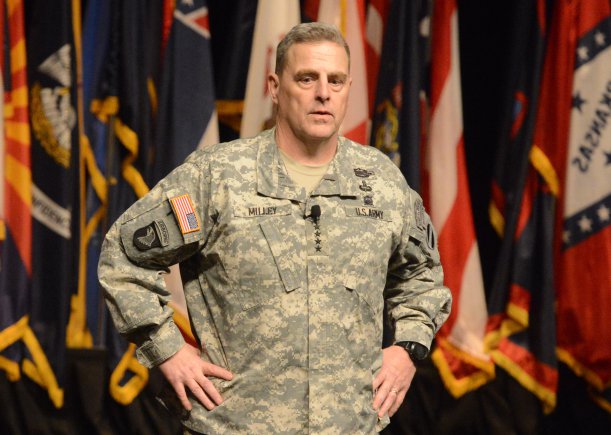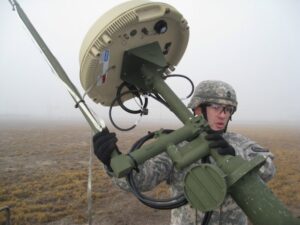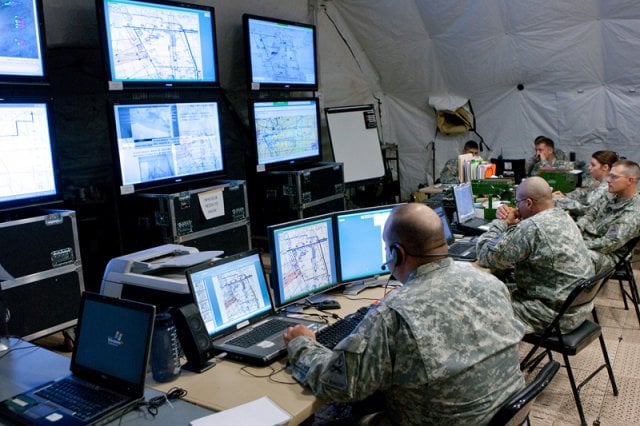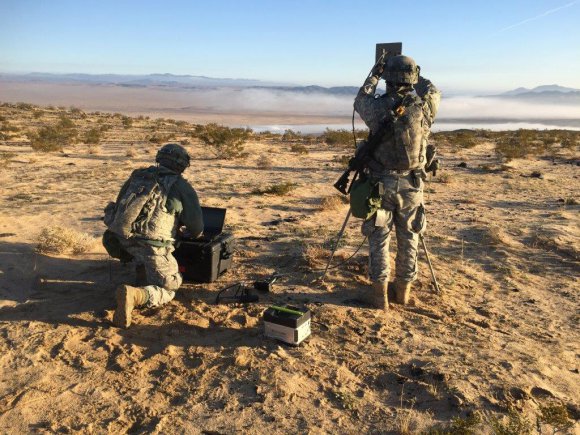
Gen. Mark Milley
ARLINGTON: Want to sell information technology to the US Army? Then you need to write this down: Paul.A.Ostrowski.mil@mail.mil. That’s the email of the general seeking industry’s input — historically something of a struggle for the service — as the Army reviews and overhauls its networks.
The Army’s long-term goal: a single unified network connecting everything from the home base to the battlefield, easy for the service to upgrade, easy for soldiers to use amidst the stress of combat, and hard for enemies to take down. The Army’s immediate question for industry: Can you build it?

An Army soldier sets up a highband antenna.
Lt. Gen. Ostrowski, the director of the Army Acquisition Corps, wants you to write him if you want in on a series of roundtables the Army is holding with selected companies, hosted by the federally funded Institute for Defense Analyses (IDA). One roundtable was personally led by the Army Chief of Staff, the hard-charging, wisecracking Gen. Mark Milley, who is taking a hands-on role in the review he launched in May.
“Who’s in charge? The Chief’s in charge…. he and the Secretary of the Army,” Ostrowski said at yesterday’s Association of the US Army conference on networks. Those top leaders have brought together the Army’s Chief Information Officer/G-6 (chief signals officer), the Army resourcing staff (G-8), the Training & Doctrine Command that brainstorms future warfare concepts and writes requirements for new systems, and the acquisition officials who buy them.
“What’s different is the involvement of the leadership,” said Army CIO Gary Wang, who’s leading the review for Gen. Milley. While the Pentagon bureaucracy does plenty of reviews, he told me, “oftentimes it’s delegated down to a much lower level.” This time, though, the severity of the Army’s “financial constraints” have gotten the Chief of Staff and Acting Army Secretary Robert Speer personally involved, Wang said.
There’s another reason Wang didn’t mention: the savage criticism in Congress of the Army’s flagship battlefield network, WIN-T. Gen. Milley himself said the network is too “fragile” and “vulnerable” for future battles against high-tech adversaries like Russia or China, because its transmissions are too easily detected and then jammed or hacked.

Army command post
Beyond WIN-T
“WIN-T’s our current network,” Ostrowski said when I asked him about the system. “We’re an Army that has to fight tonight, and WIN-T will be very much part of that. Period. That gets that off the table.” Then he moved on to other topics — notably not saying what this review would mean for WIN-T in the future.

Army WIN-T Tactical Communications Node.
But this review goes well beyond WIN-T, Milley and Speer have emphasized. It covers all the Army’s networks, both for combat units and back-office business operations. The crucial issue, Ostrowski said, is “how do we simplify the network? Right now we have a lot of parts and pieces. We’ve gone out and bought a lot of stuff that’s incredible in terms of its capabilities. but we’ve got to simplify: We’ve got to make this soldier-intuitive; we’ve got to make it soldier-maintainable and soldier-operable.”
The Army today has about 20 different software “baselines,” with different units and offices using inconsistent and often incompatible programs, often because their hardware is too old to handle anything better. The resulting patchwork of networks is expensive to operate and difficult to secure against cyber attack. So the service wants to upgrade everyone to a single, consistent, up-to-date baseline within two years.
What’s more, cybersecurity in the narrow sense is not enough. The Army can’t just focus on hackers sending malicious code over the internet: It also has to worry about electronic warriors jamming, triangulating, or eavesdropping on radio transmissions. That’s a uniquely military problem. Yes, civilian mobile phones also rely on radio — that’s what “wireless” means — but only to reach the nearest cell tower, which is often plugged into fiber optic cable; battlefield wireless networks rely on long-distance radio, which is much more vulnerable.

Cyber soldiers from the 780th Military Intelligence Brigade in the desert at the National Training Center.
A Daunting Task
So what does the Army want from its future network, and therefore from industry?
First and most fundamentally, Ostrowski told the AUSA conference, the review is driven by rapidly evolving threats, because the network needs to be ready to go to “fight and win our nation’s wars” against those threats. The Army must stand ready “to deploy rapidly, anywhere, anytime, to shape, prevent, and win, against any foe in any domain — domain being cyber, space, air, land, or maritime — and any environment — environment being megacity, desert, jungle, arctic.” So the network must be able to operate, and the soldiers using it must be able to reliably communicate, in all those conditions, under attack by any of those threats, and on the move, without stopping to set up radio antennas or lay fiber optic cables.

Army Strykers cross a temporary bridge in Romania during exercise “Dragoon Crossing.”
To that end, the network must be “simple and intuitive,” Ostrowski said, easy for soldiers to operate without extensive training or constant tweaking. Soldiers must be able to keep it running without relying on legions of industry Field Service Representatives (FSR), as was often the case in Afghanistan and Iraq.
The network must also be easy to upgrade as technology changes, without having to start the whole laborious procurement process over again, and without being locked in to one company’s intellectual property that no one firm can touch. “I will tell you up front, that if you’re going to bring proprietary solutions to the table, don’t come,” Ostrowski said. Instead, the network must be built on open standards, allowing any company to offer upgrades just as any company that meets Apple’s standards can sell apps for the iPhone.
Just as the network has to be open to different companies’ products, Ostrowski continued, “it has to be accessible to our allied partners,” allowing friendly nations’ networks to connect with ours.
Finally, the network must be secure against cyberattack, resilient to the damage of those attacks that do get through, and able to transmit its wireless signals in a way the enemy cannot easily detect. (The technical terms are Low Probability of Detection (LPD) and Low Probability of Intercept (LPI)).
This is a daunting list of desiderata, but engineers from both the Army and “numerous companies” are already “whiteboarding” how they would achieve them, Ostrowski said. “My name and number (are) up there,” he said, pointing to his slides. “I need you to let me know if you want to play.”
Who’s facilitating all this interaction? The Institute for Defense Analyses (IDA), a federally funded research & development cooperation that Congress had already chartered to study the Army network, said Maj. Gen. Peter Gallagher, who works for CIO Wang as director of architecture, operations, networks, and space. Gallagher told me he doubted if he’d ever seen a review this intensive, adding the full-court outreach to industry was “something Gen. Milley personally directed.”
“We rely on industry for everything we do,” Gallagher said simply.
Army eyes TBI monitoring, wearable tech for soldiers in high-risk billets
“We are also looking at what additional personal protective equipment we can provide to our folks, especially instructors and others who are routinely exposed to blast pressure,” said Army Secretary Christine Wormuth.


























